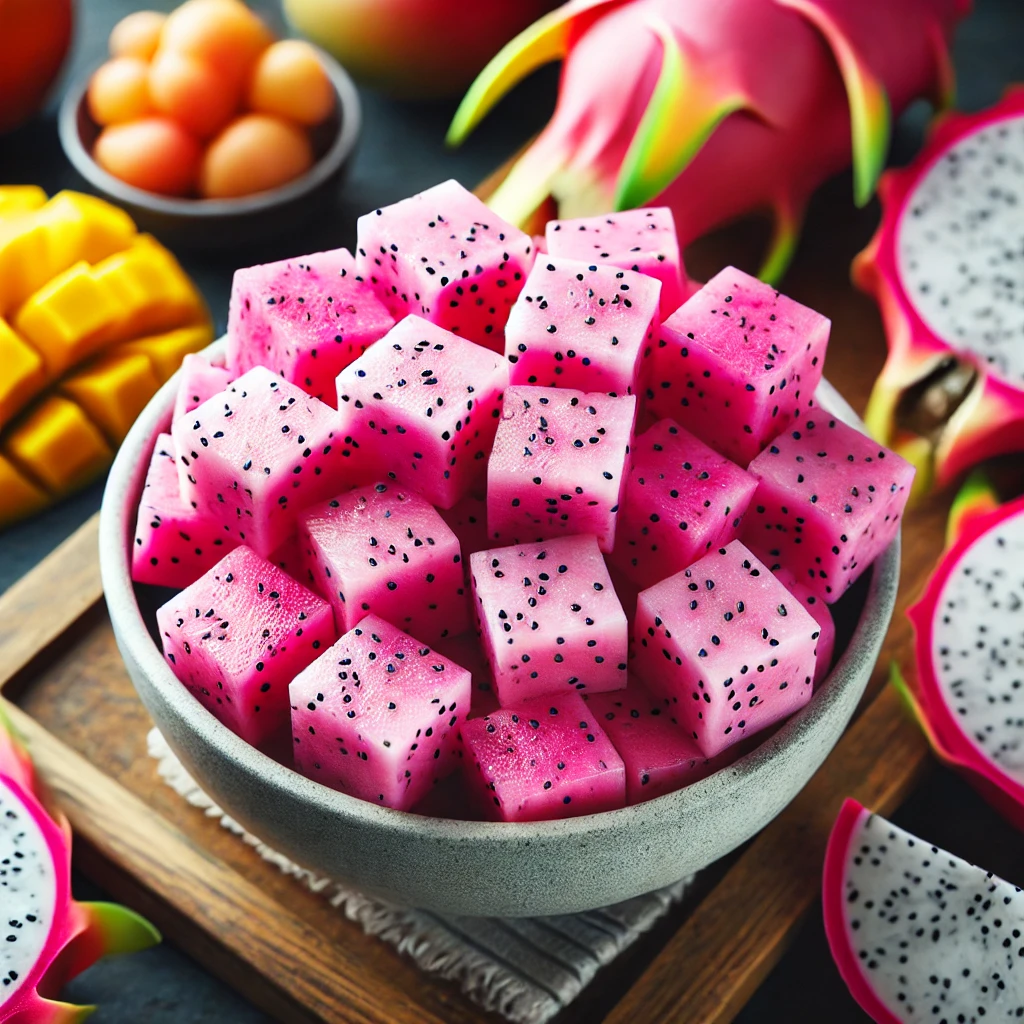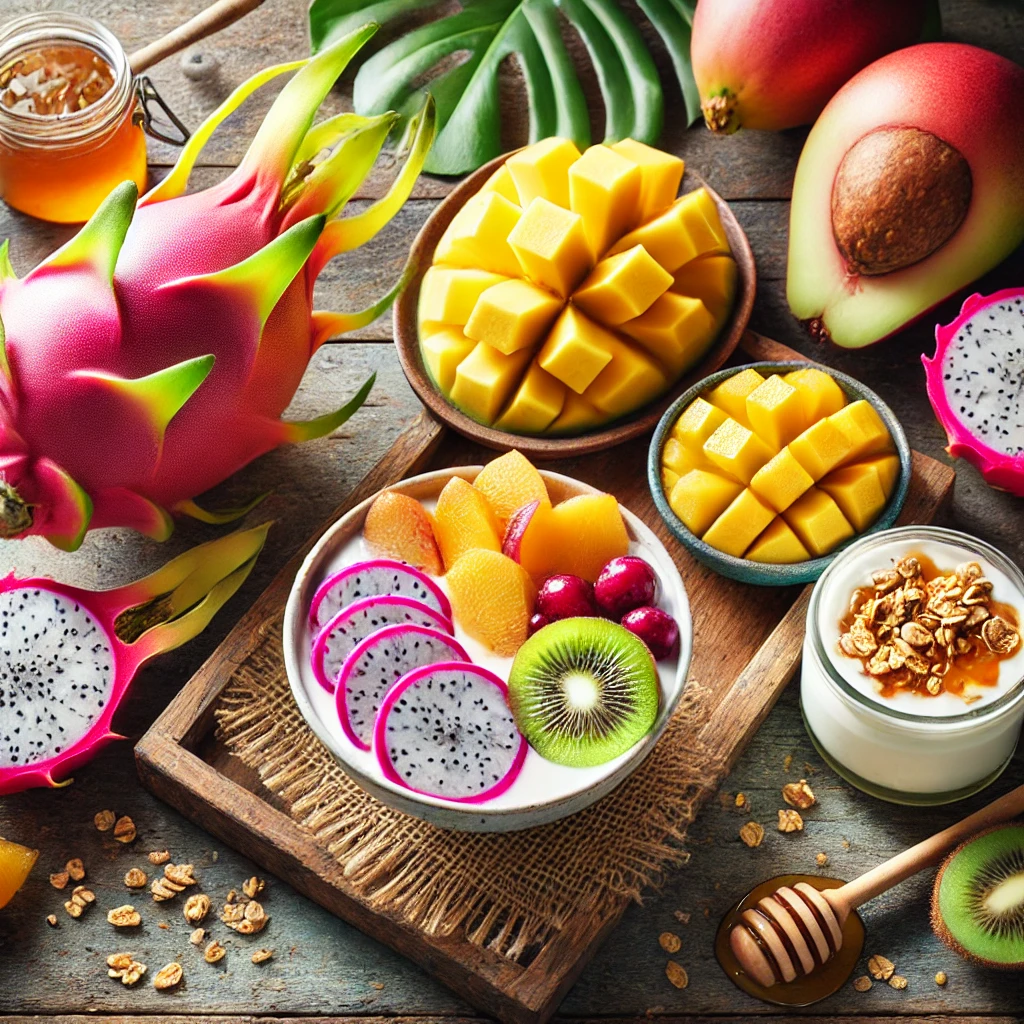Dragon fruit, with its striking appearance and subtle sweetness, has become a favorite among health-conscious eaters and food enthusiasts. Whether you’re curious about how to prepare this exotic fruit or looking to add a pop of color to your dishes, mastering the art of cutting and serving dragon fruit is easier than you think. In this guide, we’ll walk you through four creative ways to cut dragon fruit, suggest delicious pairings, and offer tips on crafting Instagram-worthy plates. We’ll also dive into the health benefits of dragon fruit and explore its different varieties.
1. The Quick Slice: Easy, Fast, and Delicious

For those who are new to dragon fruit or just want a quick and easy way to enjoy it, the quick slice method is perfect. This method is simple, requiring minimal effort, and results in ready-to-eat slices or cubes.
How to Do It:
- Start with a Clean Fruit: Rinse the dragon fruit under cold water to remove any dirt or debris.
- Trim the Ends: Place the dragon fruit on a cutting board and carefully slice off both ends using a sharp knife. This gives the fruit a stable base for the next steps.
- Slice it in Half: Stand the fruit upright on one of the flat ends. Slice it vertically down the middle to create two halves. Inside, you’ll see the vibrant flesh dotted with tiny black seeds.
- Scoop or Peel: You can either scoop out the flesh with a spoon in one go or peel away the skin using your fingers. The flesh should separate easily from the skin.
- Cut into Rounds or Cubes: If you scooped the flesh out in one piece, lay it flat on the cutting board and slice it into rounds. For cubes, cut the rounds into bite-sized pieces.
Perfect For: Quick snacks, adding to fruit salads, or topping on yogurt and smoothies.
Pro Tip: If you’re in a hurry, you can skip the peeling step by eating the dragon fruit directly out of the skin with a spoon, similar to how you’d eat a kiwi.
2. Fancy Wedges: Serve It with Style

If you’re planning to serve dragon fruit at a dinner party or want to add a touch of elegance to your dish, cutting the fruit into wedges is the way to go. This method not only makes the fruit easy to eat but also looks impressive on any plate.
How to Do It:
- Prepare the Fruit: Rinse the dragon fruit and cut off both ends as in the previous method.
- Slice in Half: Stand the fruit upright and slice it vertically to create two halves.
- Cut into Wedges: Without removing the skin, cut each half into 3-4 wedges, depending on the size of the fruit. This should give you 6-8 wedges per fruit.
- Loosen the Flesh: Using your knife, gently run it between the skin and the flesh of each wedge to loosen the fruit, but leave the flesh attached at the base. This keeps the wedge intact but makes it easier for guests to eat.
- Fan Out for Presentation: Slightly fan out the wedges on a plate for a visually appealing display.
Perfect For: Dessert platters, fruit boards, or as a garnish for cocktails.
Pro Tip: For an extra touch, drizzle the wedges with honey or lime juice, and sprinkle with a little sea salt to enhance the flavor.
3. Cubed Fun: Bite-Sized Goodness

Cubing dragon fruit is a great option for salads, smoothie bowls, or making easy-to-eat snacks. This method is especially kid-friendly, as the small, colorful pieces are fun and easy to handle.
How to Do It:
- Clean and Cut: Rinse the dragon fruit, cut off both ends, and slice it in half as before.
- Score the Flesh: Hold one half of the dragon fruit, flesh-side up. Using a knife, score the flesh into a grid pattern—horizontal and vertical lines—without cutting through the skin.
- Scoop Out the Cubes: Take a spoon and gently scoop out the cubes. They should easily pop out, ready to eat or use in recipes.
Perfect For: Fruit salads, smoothie bowls, snacks, or as a colorful topping for desserts.
Pro Tip: Add the cubed dragon fruit to a tropical fruit salad with mango, pineapple, and kiwi for a refreshing and vibrant dish.
4. Perfect Pairings: Delicious Companions for Dragon Fruit

While dragon fruit is delightful on its own, pairing it with other ingredients can elevate its flavor and texture. Here are some ideas to help you create a balanced and delicious plate:
- Tropical Fruits: Dragon fruit pairs beautifully with other tropical fruits like mango, pineapple, and kiwi. The mix of flavors and colors makes for an eye-catching and tasty fruit salad.
- Yogurt & Granola: For a healthy breakfast or snack, add cubed dragon fruit to Greek yogurt and top with granola and a drizzle of honey. The creaminess of the yogurt complements the fruit’s mild sweetness.
- Soft Cheeses: Soft cheeses like ricotta, mascarpone, or even cream cheese work well with dragon fruit. The subtle tang of the cheese balances the fruit’s flavor, making it a great addition to cheese boards.
- Coconut: Coconut flakes, coconut milk, or coconut cream add a tropical twist when paired with dragon fruit. The rich, nutty flavor of coconut enhances the fruit’s delicate taste.
- Mint & Lime: A squeeze of lime juice and a sprinkle of fresh mint can take dragon fruit to the next level, adding a refreshing and zesty contrast.
Pro Tip: For a more indulgent treat, try pairing dragon fruit with dark chocolate. The bitterness of the chocolate complements the fruit’s sweetness beautifully.
5. Crafting an Instagram-Worthy Dragon Fruit Presentation

Dragon fruit is naturally photogenic, but with a few tips and tricks, you can create plates that are not only delicious but also Instagram-worthy. Here’s how to make your dragon fruit dishes pop on social media:
- Play with Colors: Dragon fruit’s vibrant pink skin and contrasting white or red flesh are perfect for creating visually striking plates. Pair it with other colorful fruits like blueberries, strawberries, or pomegranate seeds to create a rainbow of colors.
- Texture Matters: Incorporate different textures to add interest to your plate. Use crunchy elements like nuts, seeds, or granola alongside the soft, juicy dragon fruit.
- Flower Power: Edible flowers such as violets, pansies, or nasturtiums can add a touch of elegance and a splash of color to your presentation. Scatter them around the plate for a natural, artistic look.
- Artistic Arrangements: Arrange the fruit in spirals, concentric circles, or other geometric patterns. A well-organized plate looks polished and professional.
- Finishing Touches: A drizzle of honey, a dusting of powdered sugar, or a sprinkle of sea salt can add the finishing touch to your plate, making it both beautiful and delicious.
Pro Tip: Use natural light when photographing your dishes to bring out the vibrant colors and textures of the dragon fruit.
6. Dragon Fruit: the Health Benefits

Dragon fruit isn’t just a pretty face—it’s also packed with nutrients that make it a great addition to a healthy diet. Here are some of the key benefits:
- Antioxidant Powerhouse: Dragon fruit is rich in antioxidants, particularly vitamin C. Antioxidants help protect your body from free radicals, reducing the risk of chronic diseases.
- High in Fiber: With a good amount of dietary fiber, dragon fruit supports healthy digestion and can help regulate blood sugar levels, making it a smart choice for those managing diabetes.
- Low in Calories: Despite its sweet taste, dragon fruit is low in calories, making it a guilt-free snack or dessert option for those watching their weight.
- Boosts Immunity: The high vitamin C content not only acts as an antioxidant but also strengthens your immune system, helping your body fight off illnesses.
- Promotes Skin Health: The combination of antioxidants, vitamins, and hydration can contribute to healthier, more radiant skin. Dragon fruit is also used in skincare products for its soothing and anti-aging properties.
Pro Tip: Incorporate dragon fruit into your diet regularly to enjoy these health benefits, whether in smoothies, salads, or as a simple snack.
7. Different Types of Dragon Fruit

Dragon fruit comes in several varieties, each with its own unique characteristics. Understanding these differences can help you choose the right one for your needs:
- Classic White (Hylocereus undatus): The most common variety, it has pink skin and white flesh speckled with small black seeds. Its flavor is mild, slightly sweet, and it’s widely available in supermarkets.
- Red Royalty (Hylocereus costaricensis): Known for its deep red or magenta flesh, this variety has a bolder, sweeter flavor compared to the white-fleshed type. It’s visually striking and adds a pop of color to any dish.
- Yellow Sunshine (Hylocereus megalanthus): This variety is smaller with yellow skin and white flesh. It’s slightly sweeter and more aromatic, with a unique flavor profile that’s often described as more intense than the other varieties.
Origins: Dragon fruit is native to Central and South America but has become popular in tropical and subtropical regions worldwide. Today, it’s widely cultivated in countries like Vietnam, Thailand, Mexico, Israel, and Australia.
Pro Tip: If you’re looking to impress with vibrant colors, opt for the red or yellow varieties. They not only look stunning but also offer a different taste experience.
FAQ:
- How to Select and Store Dragon Fruit: https://www.thespruceeats.com/how-to-buy-store-and-prepare-dragon-fruit-1388675
- Dragon Fruit Health Benefits: https://www.healthline.com/nutrition/dragon-fruit-benefits
- Dragon Fruit Recipes: https://www.bbcgoodfood.com/howto/guide/best-dragon-fruit-recipes
- Types of Dragon Fruit: A Complete Guide: https://www.specialtyproduce.com/produce/Dragon_Fruit_11387.php
- How to Grow Your Own Dragon Fruit: https://www.gardeningknowhow.com/edible/fruits/dragon-fruit/growing-dragon-fruit.htm


Leave a Reply